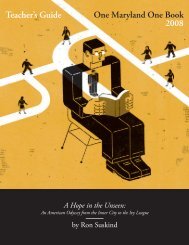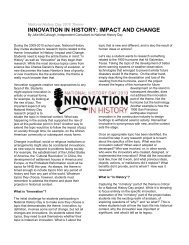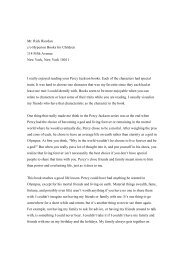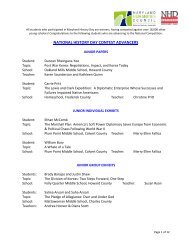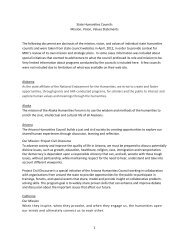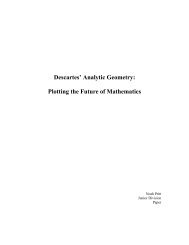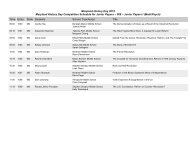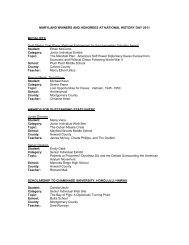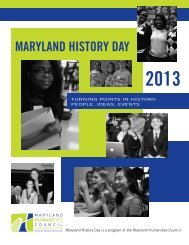Sample Process Paper and Annotated Bibliography - Maryland ...
Sample Process Paper and Annotated Bibliography - Maryland ...
Sample Process Paper and Annotated Bibliography - Maryland ...
Create successful ePaper yourself
Turn your PDF publications into a flip-book with our unique Google optimized e-Paper software.
SAMPLE PROCESS PAPER AND ANNOTATED BIBLIOGRAPHY<br />
The <strong>Process</strong> <strong>Paper</strong> should be no longer than 500 words <strong>and</strong> should explain how<br />
• you chose your topic<br />
• you conducted your research<br />
• you selected your presentation category <strong>and</strong> created your project<br />
• your project relates to the National History Day theme<br />
The <strong>Annotated</strong> <strong>Bibliography</strong> should<br />
• contain all sources that provided usable information or new perspectives in<br />
preparing your entry<br />
• list only those sources that contributed to the development of your entry<br />
• include sources of visual materials <strong>and</strong> oral interviews<br />
• provide annotations that explain how you used the source <strong>and</strong> how it helped<br />
you underst<strong>and</strong> your topic<br />
• be separated into primary <strong>and</strong> secondary sources<br />
• use a consistent style, either Turabian or MLA<br />
The following sample process paper <strong>and</strong> annotated bibliography are from a Junior<br />
Individual Documentary that competed at National History Day 2006.<br />
St<strong>and</strong> or Stunt?<br />
The Sensational Trial of John Thomas Scopes<br />
Lauren White<br />
Junior Division<br />
Individual Documentary<br />
Choosing a topic fitting the History Day theme, “Taking a St<strong>and</strong> in History:<br />
People, Ideas, Events,” happened quite by accident this past summer when I found myself<br />
watching the 1960’s film “Inherit the Wind.” My first impression was, “Wow! This story<br />
portrays a real-life st<strong>and</strong> taken against an unjust law.” I knew then that I had found my<br />
topic: the trial of John Thomas Scopes, although, at the time, I did not know the<br />
defendant’s real name. My interest was piqued when I learned that the story depicted in
the film had little to do with the facts of the case upon which it is commonly thought to<br />
be based. Amazingly, in the real-life trial, John Scopes was convicted of teaching<br />
evolution without ever having taught Biology. The ACLU used Scopes as a pawn for its<br />
cause <strong>and</strong>, at the same time, the townspeople of Dayton used the trial as a publicity stunt<br />
seeking economic gain.<br />
I conducted my research into the Scopes trial through the use of primary <strong>and</strong><br />
secondary sources obtained during visits to the University of Maryl<strong>and</strong> library, the<br />
Scopes Trial Museum <strong>and</strong> Court House in Dayton, Tennessee, <strong>and</strong> the Bryan College<br />
Archives, which included an interview with Scopes Trial specialist <strong>and</strong> author of many<br />
publications on the subject, Dr. Richard Cornelius. The trip to Dayton offered the<br />
opportunity to speak with other authorities on the trial, as well, which was particularly<br />
invaluable to my research because it helped me wade through the huge amount of<br />
information, including much misinformation, published on the trial over the years.<br />
Because of the sensational nature of the trial <strong>and</strong> the large number of photographs<br />
available, I felt a documentary would best convey my ideas. As the old adage goes, “A<br />
picture is worth 10,000 words.” Images in the documentary include photographs from<br />
collections of the University of Tennessee, Bryan College Special Collections, the<br />
Library of Congress, the Smithsonian Archives, the Chicago Historical Society, <strong>and</strong><br />
photographs <strong>and</strong> video I took at the site of the trial <strong>and</strong> during an interview with Dr.<br />
Cornelius. Clips <strong>and</strong> newsreel footage from existing films were added to enhance the<br />
project. The documentary was produced through the use of Final Cut Pro software,<br />
which entailed placing the images <strong>and</strong> film clips in order, combining them with recorded
narration, music, transitions <strong>and</strong> effects such as panning <strong>and</strong> zooming, <strong>and</strong> recording the<br />
final product onto DVD disk.<br />
The Scopes Trial proved to be an ideal topic for the theme, “Taking a St<strong>and</strong> in<br />
History.” Even though the st<strong>and</strong> taken by John Scopes against the law banning the<br />
teaching of evolution in Tennessee public schools was orchestrated <strong>and</strong> started as a<br />
publicity stunt, various participants took genuine st<strong>and</strong>s that represented enduring<br />
conflicting ideas in American society. The trial gave worldwide focus to the debate over<br />
creationism versus evolution, as well as the issue of academic rights <strong>and</strong> the question of<br />
citizens’ rights to control their own schools. All of these issues remain controversial <strong>and</strong><br />
unresolved in our society today.<br />
Primary Sources<br />
Word count: 500<br />
<strong>Annotated</strong> <strong>Bibliography</strong><br />
American Civil Liberties Union. “Plan Assault on State Law on Evolution.” Daily Times:<br />
Chattanooga, Tenn. [Chattanooga] 4 May 1925.<br />
This newspaper article, posted by the ACLU in a popular Tennessee publication,<br />
stating that it was looking for a teacher to test the new anti-evolution law in<br />
Tennessee, gives insight into the events leading up to the Scopes trial. A<br />
photograph of the newspaper page on which this article appeared is used in the<br />
documentary.<br />
America, A look Back: The Jazz Age. 1989. Videocassette. NBC News Productions.<br />
This videocassette production is a compilation of newsreel footage of life in<br />
America during the 1920’s with narration by Tom Brokaw. This source is listed<br />
as primary because the video includes newsreel footage in its original form. Two<br />
short segments of this film are used in this project to help put the Scopes trial into<br />
historical context.<br />
Berryman, Clifford Kennedy. Evolution in Tennessee. Drawing. 1925. Library of<br />
Congress, Washington, D.C.
This cartoon depicting the “evolution” of the townspeople of Dayton during the<br />
Scopes trial aided greatly in the underst<strong>and</strong>ing of how the media distorted the<br />
facts of the trial. A photograph of this cartoon is used in the documentary.<br />
- - -. My first real bath; gee! ain’t it great! Drawing. 1925. Library of Congress,<br />
Washington, D.C.<br />
This cartoon depicting Dayton residents as country yokels is an excellent example<br />
of how the Dayton citizens were unjustly portrayed by the media. A photograph<br />
of this cartoon is used in the documentary.<br />
Best Minds. Drawing. 1925. Library of Congress, Washington, D.C.<br />
This cartoon depicting William Jennings Bryan as a man blind to science is one of<br />
the many examples of how the press portrayed Bryan as an ignorant bigot <strong>and</strong><br />
focused most of its reporting on the evolution side of the issues that became<br />
prominent in the Scopes trial. A photograph of this cartoon is used in the<br />
documentary.<br />
Bryan, William Jennings, <strong>and</strong> Mary Baird Bryan. The Memoirs of William Jennings<br />
Bryan. Philadelphia: Winston, 1925.<br />
This autobiographical book is extremely helpful in getting a feel for the<br />
personality of William Jennings Bryan <strong>and</strong> aids in the underst<strong>and</strong>ing of his<br />
interest in the Scopes trial as well as his life before the trial.<br />
Cornelius, Richard M., ed. Selected Orations of William Jennings Bryan: 75th<br />
Anniversary Edition, with an essay by Pulitzer Prizewinner Edward J. Larson.<br />
Dayton: Bryan College, 2003.<br />
This collection of transcripts of several of William Jennings Bryan’s speeches<br />
gave insight into the personality of Bryan <strong>and</strong> the strength of his fundamentalist<br />
beliefs, as well as attesting to his keen oratorical skills.<br />
Darrow, Clarence. The Story of My Life. New York: Scribner’s, 1932.<br />
This autobiographical book aids in the underst<strong>and</strong>ing of how <strong>and</strong> why Clarence<br />
Darrow became involved in the Scopes trial. It gives insight into his strong<br />
personality as a defense lawyer <strong>and</strong> the differences between his philosophies <strong>and</strong><br />
those of William Jennings Bryan.<br />
Darwin, Charles, M.A. The Origin of Species by Means of Natural Selection. 1859. 6 th ed.<br />
London: Murray, 1885.
Darwin’s published work about the origin of species explained the theory on<br />
which the section on evolution in Dayton’s high school textbook was based <strong>and</strong><br />
adds greatly to the underst<strong>and</strong>ing of the controversy between the beliefs of<br />
fundamentalist Christians <strong>and</strong> evolutionists. Giving this controversy worldwide<br />
focus was a major historical impact of the Scopes trial. A photograph of the cover<br />
page of this book is used in the documentary.<br />
Downtown Dayton, Tennessee July 1925. Photograph. Science Service Records 1902-<br />
1965. Smithsonian Archives, Washington, D.C.<br />
This photograph of a street in Dayton, Tennessee was used as a visual image in<br />
the documentary to set the scene of the trial.<br />
"Evolution Trial." Cartoon. New York Times 12 July 1925.<br />
This cartoon showing a monkey with human abilities aids greatly in the<br />
underst<strong>and</strong>ing of how the media’s coverage of the trial was sensationalized. A<br />
photograph of this cartoon is used in the documentary.<br />
House Bill No. 64, Public Acts of the State of Tennessee Passed by the Eighty-fifth<br />
General Assembly. 17 May 1967.<br />
This document, which is a part of the permanent records of the State of<br />
Tennessee’s General Assembly, is the legislation repealing the Butler Act. The<br />
significance of this source is that it documents the forty-two year span of time in<br />
which the Butler Act was an active law in Tennessee.<br />
House Bill No. 185, Public Acts of the State of Tennessee Passed by the Sixty-fourth<br />
General Assembly. 21 Mar. 1925.<br />
This document, known as the Butler Act, is from the official records of the<br />
Tennessee general assembly <strong>and</strong> is an extremely important research item because<br />
it contains the wording of the law that was supposedly broken by the defendant of<br />
the Scopes trial. A photograph of this document is used in the documentary.<br />
Hunter, George William. A Civic Biology. New York: American, 1914.<br />
A Civic Biology was the textbook used in Dayton’s high school biology class<br />
before the Scopes trial. Its importance to this project is that it documents that the<br />
subject of evolution was included in an American high school curriculum. When<br />
compared to the revised version of the book that was published in 1926, one can<br />
see the effect that the Scopes trial had on downplaying evolution in school course<br />
work.<br />
- - -. New Civic Biology. New York: American, 1926.
In 1926, the textbook A Civic Biology was revised <strong>and</strong> renamed The New Civic<br />
Biology. When comparing the text of both books one can see that the word<br />
“evolution” was removed <strong>and</strong> that there was little said about the origin of man.<br />
This change is evidence that the Scopes trial affected the downplaying of<br />
evolution in textbooks.<br />
Inherit the Wind. 1960. Videocassette. MGM/United Artists, 1996.<br />
This videocassette recording of the film Inherit the Wind, commonly thought to<br />
be a docudrama of the Scopes trial, was extremely useful in evaluating the<br />
distorting effect it had on American society’s perception of the Scopes trial.<br />
When comparing it to the actual transcript <strong>and</strong> other primary sources, it becomes<br />
apparent that it is only loosely based on the events of the real trial.<br />
"John T. Scopes Found Guilty: Jury Convicts On Request of Defense Counsel." Olean<br />
Evening Times [Olean] 21 July 1925, Vol. LXV. No. 150 ed.: 1.<br />
NewspaperARCHIVE.com. Heritage Microfilm. 17 Jan. 2006<br />
.<br />
This newspaper account of the end of the Scopes trial documents the fact that<br />
John Scopes was found guilty at the request of Clarence Darrow, a member of his<br />
own defense team. It also speculates that Darrow planned the outcome from the<br />
beginning.<br />
Levy, Leonard W., ed. The World’s Most Famous Court Trial: Tennessee v. John<br />
Thomas Scopes. 1925. New York: Da Capo Press, 1971.<br />
This book is a reprint of the original court transcript from the 1925 Scopes trial<br />
<strong>and</strong> is an excellent reference for confirming facts about the trial when there are<br />
conflicting accounts in other sources.<br />
Men at the control panels in a room at the Chicago Daily News radio station WMAQ.<br />
Photograph. 1925. Chicago Daily News negatives collection, Chicago Historical<br />
Society, Chicago.<br />
This photo of a radio room in Chicago receiving <strong>and</strong> broadcasting the proceedings<br />
of the Scopes trial is used as a visual image in the documentary.<br />
“Monkey Business.” Songs generated from the Scopes Trial. Audiocassette. Bryan<br />
College Archives.<br />
This audio recording was made from an original record from 1925 <strong>and</strong> contains<br />
songs with lyrics about the Scopes trial. A segment of the song “Monkey<br />
Business” was used in the audio track of the documentary.
‘Neath palms <strong>and</strong> sunshine; William Jennings Bryan’s Presbyterian Tourist Bible Class,<br />
Miami, Fla., Feb. 6th, 1921. Photograph. 1921. W. A. Fishbaugh, Library of<br />
Congress, Washington, D.C.<br />
This photograph is of William Jennings Bryan speaking to an assembly of people<br />
about the bible. The large crowd that he draws is evidence of Bryan’s reputation<br />
for having great oratorical skills.<br />
NewspaperARCHIVE.com. Heritage Microfilm. 17 Jan. 2006<br />
.<br />
This source is an extremely useful research tool. It is an archive of newspapers<br />
from the 1800’s to the present containing actual scanned images of the newspaper<br />
pages, not just transcripts of articles. Dozens of articles about the Scopes trial<br />
showing evidence of the biased <strong>and</strong> sensational press coverage can be found at<br />
this Web site. Articles used as images in the documentary are cited separately in<br />
the bibliography.<br />
"No Wonder the Monkeys Are Worried." Cartoon. Nashville Tennessean. 29 June 1925:<br />
4.<br />
This cartoon depicting monkeys with human characteristics aids greatly in the<br />
underst<strong>and</strong>ing of how the media sensationalized the evolution side of the issues<br />
during the Scopes trial. A photograph of this cartoon is used in the documentary.<br />
Olson, Steven P. The Trial of John T. Scopes: A Primary Source Account. New York:<br />
Rosen Publishing Group, 2004.<br />
This book uses primary source documents to explain the events surrounding the<br />
Scopes trial <strong>and</strong> the impact of the trial on history. It contained images of many of<br />
the sources. Not only did it help in the underst<strong>and</strong>ing of the topic, but it also aided<br />
in finding primary source documents to use in the research process for this<br />
documentary.<br />
Scientists summoned to testify at Scopes trial, July 1925. Photograph. Science Service<br />
Records 1902 –1965. Smithsonian Archives, Washington, D.C.<br />
This photograph of a group of scientists who were called to Dayton to testify for<br />
the defense was used as a visual image in the documentary when introducing the<br />
fact that Darrow wanted to include testimony about the validity of the theory of<br />
evolution in the trial.<br />
Scopes, John T. Television interview. 1970. Found in Twelve Days in Dayton: The<br />
Scopes Monkey Trial. Cole, Kip, prod. Chattanooga PBS Channel WTCI-TV 45,<br />
2001.
Included in this source is video footage from 1970 containing the last interview<br />
given by John Scopes before his death on Oct. 21, 1970. A segment of this<br />
interview, where he admits that he did not teach evolution, is used in the<br />
documentary.<br />
Scopes, John T., <strong>and</strong> James Presley. Center of the Storm: Memoirs of John T. Scopes.<br />
New York: Holt, Rinehart <strong>and</strong> Winston, 1967.<br />
This autobiographical source contains Scopes’ recollections of the trial <strong>and</strong> was<br />
useful in determining the role he played in the trial as well as confirming that he<br />
never actually taught evolution.<br />
"Scopes Trial Opens Today: Tennessee Re-Indicts John Thomas Scopes on Anti-<br />
Evolution Law." Olean Evening Times [Olean] 10 July 1925, Vol. LXV., No. 141<br />
ed.: 1. NewspaperARCHIVE.com. Heritage Microfilm. 17 Jan. 2006<br />
.<br />
This newspaper article <strong>and</strong> front-page headline document the opening of the<br />
Scopes trial proceedings on July 10, 1925. It is a good example of the<br />
sensationalized coverage of the trial by the media. A photograph of this frontpage<br />
article is used in the documentary.<br />
Vedantam, Shankar. “Eden <strong>and</strong> Evolution.” The Washington Post Magazine, February 6,<br />
2006, p. 8-15.<br />
This magazine article is documentation that the evolution versus creationism issue<br />
is still relevant today. The cover image of the magazine, which featured this<br />
article, is used as an image in the documentary when stating that the debate<br />
continues into the present.<br />
Verdict. Drawing. 1925. Library of Congress, Washington, D.C.<br />
This cartoon depicting William Jennings Bryan telling a child not to think is one<br />
of the many examples of how the press portrayed Bryan as a religious zealot <strong>and</strong><br />
focused most of their reporting on the evolution side of the issues that became<br />
prominent in the Scopes trial. A photograph of this cartoon is used in the<br />
documentary.<br />
W. C. Robinson <strong>and</strong> Sue K. Hicks Collection. Photographs. 1925. Special Collections,<br />
University of Tennessee, Knoxville.
This vast collection of photographs owned by the University of Tennessee came<br />
from the personal collections of W. C. Robinson, who was the owner of the<br />
drugstore where the plan for the trial was hatched, <strong>and</strong> Sue Hicks, a member of<br />
the prosecution team. These photographs were invaluable to this project in<br />
visually telling the story of the Scopes trial. Forty-one of the photographs were<br />
used in the documentary.<br />
“Waiting.” Cartoon. Baltimore Sun, 17 July 1925, 10.<br />
This cartoon labeling William Jennings Bryan as a religious zealot is one of the<br />
many examples of how the press portrayed Bryan in a negative manner. A<br />
photograph of this cartoon is used in the documentary.<br />
Williams Jennings Bryan sitting at a desk. Photograph. 1922. Chicago Daily News<br />
negatives collection, Chicago Historical Society, Chicago.<br />
This photograph, taken a few years before the Scopes trial, is used in the<br />
documentary to introduce William Jennings Bryan.<br />
Secondary Sources<br />
Cole, Kip, prod. Twelve Days in Dayton: The Scopes Monkey Trial. Chattanooga PBS<br />
Channel WTCI-TV 45, 2001.<br />
This film is a comprehensive account of the Scopes trial <strong>and</strong> contains several clips<br />
of newsreel footage of the actual trial. Three short segments of the trial newsreel<br />
footage were used in the documentary along with a clip of John Scopes st<strong>and</strong>ing<br />
outside of the courthouse. Additionally, a short segment of a 1970 television<br />
interview with John Scopes at 70 years of age was included in the documentary to<br />
show evidence that he had never taught evolution in the schools.<br />
- - -. “Their Stage Drew All the World: A New Look at the Scopes Evolution Trial.”<br />
Tennessee Historical Quarterly 40 (Summer 1981): 129-143.<br />
This article discusses the major events surrounding the Scopes trial <strong>and</strong> was<br />
helpful in underst<strong>and</strong>ing the sequence of events before, during, <strong>and</strong> after the trial.<br />
- - -. Underst<strong>and</strong>ing William Jennings Bryan <strong>and</strong> the Scopes Trial: A Study Guide.<br />
Dayton: Bryan College, 1998.<br />
This study guide is used in a course at Bryan College in Dayton, Tennessee <strong>and</strong><br />
contains a collection of questions that are helpful to think about when studying<br />
the Scopes trial.
Cornelius, Richard M., <strong>and</strong> Tom Davis, eds. Impact: The Scopes Trial, William Jennings<br />
Bryan, <strong>and</strong> Issues that Keep Revolving. Dayton: Bryan College, 2000.<br />
Underst<strong>and</strong>ing of the impact of the Scopes trial can be gained from reading this<br />
source containing a collection of essays focused on the impact of the Scopes trial<br />
as it relates to the creationism vs. evolution issue that is still prevalent today.<br />
Cornelius, Richard M., Ph.D. Personal interview. 16 Aug. 2005.<br />
Dr. Cornelius is an historian at Bryan College in Dayton, Tennessee <strong>and</strong> a Scopes<br />
trial specialist. During my daylong meeting with him I was able to view <strong>and</strong><br />
photograph many primary source materials from the Bryan College Archives <strong>and</strong><br />
perform an on-tape personal interview. Dr. Cornelius also gave me leads to good<br />
primary <strong>and</strong> secondary research sources so that I could get an accurate, well<br />
balanced account of the trial <strong>and</strong> its implications.<br />
Cruver, Timothy C. Personal interview. 16 Aug. 2005.<br />
Mr. Cruver is the author of You Be the Judge, a book based on the newspaper<br />
accounts of the Scopes trial. Talking with Mr. Cruver <strong>and</strong> reading his book gave<br />
me important insight into how the trial was portrayed by the press.<br />
Cruver, Timothy C., <strong>and</strong> Janet M. Cruver, eds. You Be the Judge. Dayton: E&T<br />
Enterprises, 2000.<br />
This book, written from the perspective of the newspaper coverage of the Scopes<br />
trial was important to my underst<strong>and</strong>ing of the sensationalized press coverage of<br />
the Scopes trial.<br />
De Camp, L. Sprague. The Great Monkey Trial. Garden City: Doubleday, 1968.<br />
This book discusses the major events surrounding the Scopes trial <strong>and</strong> was helpful<br />
in underst<strong>and</strong>ing the sequence of events before, during, <strong>and</strong> after the trial.<br />
Donohue, William A. The Politics of the American Civil Liberties Union. New<br />
Brunswick: Transaction Books, 1985.<br />
This book discussing the history of the ACLU gives an underst<strong>and</strong>ing of the role<br />
the ACLU plays in history <strong>and</strong>, more particularly, the role it played in the Scopes<br />
trial.<br />
Gillis, David. "Twirl, Twirl." David Gillis Debut. Indie, 2001.<br />
This recorded song was used as background music in the section of the<br />
documentary describing the events leading up to the trial. It was chosen because it<br />
conveys the emotional feeling I desired for this segment.
Ivory Winds. "Ivory Winds." Piano <strong>and</strong> Flute Sax. One World Entertainment, 2003.<br />
This recorded song was used as background music in the introductory section of<br />
the documentary as well as the section describing what transpired during the trial.<br />
It was chosen because it conveys the strong emotional feeling I desired for the<br />
introduction.<br />
Johnson, Mack. "Gloranna ." Dir. Debroy Somers. The Roaring Twenties. Pavilion<br />
Records LTD., 2000.<br />
The CD from which this song was taken contains recorded music showing the<br />
essence of the Roaring Twenties era in America. This song was used as<br />
background music to help give a feel of the time period while describing the<br />
societal changes in America during the 1920s.<br />
Larson, Edward. “75th Anniversary of the Scopes Trial.” Forum. C-SPAN. 15 July 2000.<br />
This videotape contains a discussion about the Scopes trial <strong>and</strong> its lasting impact<br />
on American society led by Edward Larson, Pulitzer Prize winning author <strong>and</strong><br />
expert on the Scopes trial.<br />
Larson, Edward J. Summer of the Gods: The Scopes Trial <strong>and</strong> America’s Continuing<br />
Debate over Science <strong>and</strong> Religion. Cambridge: Harvard University Press, 1997.<br />
This book aided in the underst<strong>and</strong>ing of the complexity of the creation versus<br />
evolution issue, which was a major focus in the Scopes trial, <strong>and</strong> how the issue is<br />
still controversial today in American society.<br />
- - -. Trial <strong>and</strong> Error: The American Controversy Over Creation <strong>and</strong> Evolution. New<br />
York: Oxford University Press, 1989.<br />
This book aided in underst<strong>and</strong>ing the complexity of the creation vs. evolution<br />
issue, which was a major focus in the Scopes trial, <strong>and</strong> how the issue is still<br />
prevalent today in American society.<br />
Larson, Edward J., Edward Caudill, <strong>and</strong> Jesse Fox Mayshark. The Scopes Trial: A<br />
Photographic History. Knoxville: University of Tennessee Press, 2000.<br />
This book tells the story of the Scopes trial primarily through photographs <strong>and</strong><br />
their captions. This book was particularly important while researching the Scopes<br />
trial because it pointed out who owned the collections from which many of the<br />
images used in this project were obtained.<br />
The Monkey Trial. In Search of History. The History Channel/A&E Television Networks.<br />
Jan. 1997.
This documentary gives an in-depth view of the Scopes trial, including the events<br />
that led up to the trial, the trial itself, <strong>and</strong> the lasting impact of the trial. It was<br />
also an important source for gaining underst<strong>and</strong>ing of the issues that became<br />
relevant during the trial of John Scopes.<br />
Moore, R<strong>and</strong>y. "The Lingering Impact of the Scopes Trial on High School Biology<br />
Textbooks." BioScience 51.9 (Sept. 2001): 790-796.<br />
This journal article was helpful in underst<strong>and</strong>ing how <strong>and</strong> why the Scopes trial<br />
influenced the teaching of evolution in the years following the trial.<br />
Moran, Jeffrey P. The Scopes Trial: A Brief History with Documents. Boston: Bedford/St.<br />
Martin’s, 2002.<br />
This book gives a basic overview of the Scopes trial <strong>and</strong> was useful when<br />
determining the most important facts to include in the time restraints of this<br />
project.<br />
Nightnoise. "Windell." At the End of the Evening. Windam Hill, 1988.<br />
This recorded song was used as background music in the section of the<br />
documentary describing the impact of the trial on history <strong>and</strong> during the<br />
conclusion. It was chosen because it conveys the emotional feeling I desired for<br />
this segment <strong>and</strong> gave the impression of moving toward a conclusion.<br />
Scopes, Jack. “The Man Who Put the Monkey on Dayton’s Back.” Chattanooga Life <strong>and</strong><br />
Leisure July 1989: 12+.<br />
This article was written by the son of John Thomas Scopes <strong>and</strong> gives great insight<br />
into how the Scopes trial affected the image of the town of Dayton <strong>and</strong> the state of<br />
Tennessee.<br />
The Scopes “Monkey” Trial 1925. L<strong>and</strong>mark American Trials. World Almanac Video.<br />
Fall 2000.<br />
This video told the Scopes trial story from the legal perspective <strong>and</strong> is helpful in<br />
underst<strong>and</strong>ing the legal aspects of the Scopes trial.



